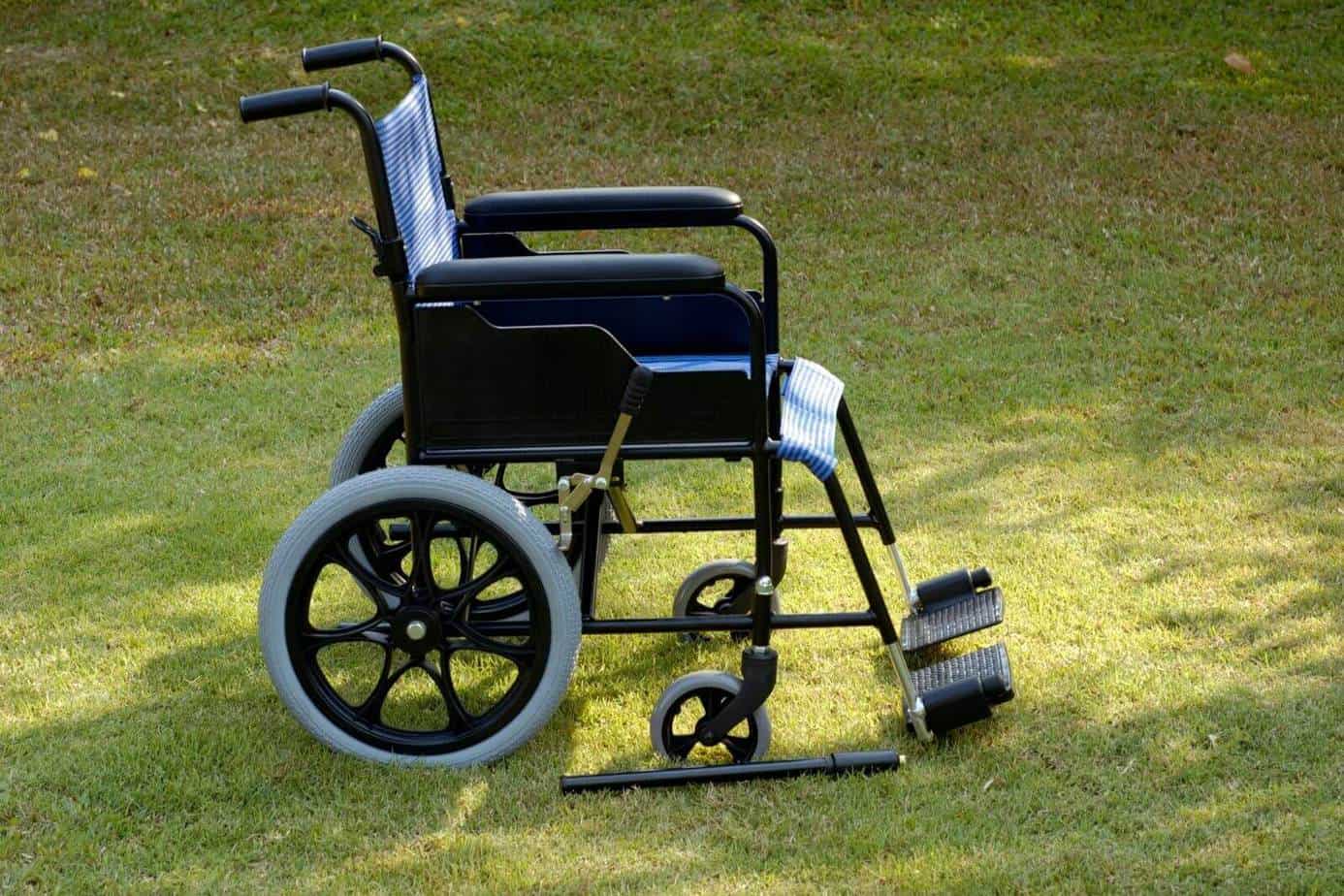What is the standard wheelchair width?
As you’ll find out, width matters when purchasing a wheelchair or traveling in one and is something to consider carefully.
Fortunately, we’re here to talk about everything you need to know about how wide a wheelchair is!
During this discussion, it’s essential to touch upon wheelchair dimensions, which play a crucial role in ensuring comfort and maneuverability for the user.
Just keep on reading.
READ MORE: 5 Best Wheelchair Accessories
Table of Contents
Standard Wheelchair Width
Talking about standard wheelchair width seems trivial at first. However, a wheelchair’s width is the difference between inclusion and exclusion for wheelchair users.
So, let’s dive in.
Standard Wheelchair Sizes
But wait – there’s more.
Usually, manufacturers list the seat width or cushion size in the wheelchair’s description. That’s not the overall width of the chair.
According to wheelchair experts, “the overall width of a manual wheelchair is 9″ wider than the seat.” That means a standard seat measuring 18″ x 16,” equals a 27-inches wide chair.
As we dive deeper into this topic, it’s evident how crucial understanding wheelchair dimensions is for selecting the right chair and ensuring accessibility in everyday environments.
Watch this recap video below:
Check: Is it Safe to Buy a Used Wheelchair?
Wheelchair Door Width
Standard Doorway Regulations
To ensure accessibility for the disabled, the Americans with Disabilities Act has guidelines that determine how wide doors must be in public buildings to ensure access for wheelchairs.
ADA’s accessibility standard states:
The minimum clear width for single wheelchair passage shall be 32 inches (815 mm) at a point for a maximum length of 24 inches and 36 inches (915 mm) continuously.
Simply put, ADA’s 2010 Design Standards call for a 32-inch wide opening so wheelchair users can pass through doors with enough clearance to avoid hitting the walls.
Powered Wheelchair Width
Electric wheelchairs have a different width than standard manual ones.
That’s something to consider when you’re choosing between manual wheelchairs and powered ones.
In general, most powered wheelchairs are 24-25 inches wide, but some are a bit wider, depending on their design and features (leg rests, swing-away armrests, etc).

Narrow power wheelchairs also exist with a width of 21.5.” Such wheelchairs have narrow seats, measuring 16 or 17 inches. They tend to be more expensive than other power chair models.
However, for power wheelchairs, their turning radius is as important as their width. As Mark Smith from Quantum Rehab explains, “the lower the number, the smaller the space needed for turning.“
So, if you’ve got a narrow wheelchair with a large turning radius, it might be hard to navigate it in a hallway or tight spaces.
But a slightly wider power chair with a small turning radius gives you better maneuverability through narrow hallways and crowded places.
So, what does this mean for you?
Power chairs are usually narrower than regular wheelchairs.
Chances are that you won’t have problems with standard doors, wheelchair-accessible buildings, and other wheelchair-friendly facilities.
Just make sure that you pay careful attention to the narrow wheelchair dimensions and get one that fits your body comfortably.
If you want to know the difference between a manual and a power wheelchair, check out this video.
Foldable Wheelchair Width
Foldable wheelchairs can be manual or electric and are design to be lightweight, easy to transport, and compact to store.
Travel wheelchairs and transport wheelchairs are usually foldable.

To provide better maneuverability through narrow doorways, foldable chairs are usually narrow than the standard wheelchair size and lighter.
But how wide are these wheelchairs?
In general, foldable chairs can be as narrow as 19 inches, depending on the seat cushion size and weight capacity. But most models are similar to power chairs and have an average wheelchair size of 23-25 inches.
For transport chairs, you can add 5 inches to the seat width to get the correct overall width of the wheelchair.
So, what does this mean for wheelchair users like you?
You shouldn’t have problems going through standard doors with a foldable wheelchair or even a 30-inch door.
Moreover, foldable wheelchairs are great for tight spaces and easy to fold and carry through tiny doors. That’s what makes them great indoor wheelchairs.
TRY READING: Weighing Scales for Wheelchair Users
How Wide Is an Extra-Wide Wheelchair?
Extra-wide wheelchairs are called bariatric or heavy-duty wheelchairs.
They’ve got a bigger seat size, increased maximum weight capacity, and additional features for maximum durability.
In general, extra-wide wheelchairs can reach up to 32 inches in width. They’re several inches wider than other models of wheelchairs and unlikely to go through 32-inch doors smoothly.

That might get you thinking why some people prefer extra-wide wheelchairs to standard wheelchair sizes.
These heavy-duty chairs come with a large seat and cushion size, which might be the only option for heavy users.
Moreover, bariatric wheelchairs provide better support and ensure a more comfortable seating position. But they tend to be expensive due to the extra features and reinforced frame.
ALSO READ: Shopping Basket for Front of Wheelchair
Here are some gift ideas all wheelchair users will love!
What to Consider When Resizing a Doorway for Wheelchair Users?
As we already explained, the standard wheelchair width for doors is 32 inches, per ADA’s guidelines.
Unfortunately, some old houses have narrower doors, which means you’ll have to resize the door width for a wheelchair.
That probably seems like a hard task, doesn’t it?
But as long as you keep consider a couple of things, you can ensure that your house wheelchair-friendly in no time.
1. Check Your Local Area Regulations
Before you start doing any remodeling to accommodate a wheelchair, you should check your local building regulations.
They’re likely to be similar to ADA’s guidelines, but you want to make sure you’re violating any residential codes. Otherwise, you might get into trouble with local building officials.
If you don’t have any experience in the home improvement area, you should consult a professional. The price for widening doors/ installing handicap doors varies, depending on what you need.
RECOMMENDED: Wheelchair Fall Prevention
2. Select the Correct Door Size
Most residential building codes have the same rules about the main entry door’s width as ADA, meaning they call for a 32-inch clear width. But that doesn’t equal a 32-inch wide door.
As specialists from Building Code Trainer point out, “to achieve a 32-inch opening, you will need at least a 36-inch door.” So, make sure that you pick the right door size or you might have to resize again.
There are no requirements for indoor doors, but common sense dictates that they shouldn’t be too narrow. Even a narrow, lightweight wheelchair will hardly fit through a tiny, 20-inch door.
In general, bathroom and hallway doors are some of the narrowest in the whole house. They usually measure between 25 and 30 inches and might need resizing.
However, their opening might be enough if you have a narrow chair.
Also Read: Can a Wheelchair Fit Through a 30 Inch Door?
3. Know Your Options
If you’re short an inch or two, you might not have to widen the doorway to accommodate a standard wheelchair.
Instead, you can try offset hinges to swing the door clear and gain an inch of clearance. Offset hinges are cheap, easy to install, and are worth trying before you move on to widening the door.
Another approach would be to remove the entire door to ensure that wheelchairs or mobility scooters have enough clearance. Then you can use curtains for privacy.
You can also remove the door and frame and then re-installed them so that the door will swing in the other direction. It’s one of the more inexpensive options and it works.
As experts say, if the door opens 180 degrees, “the door will no longer be an obstacle as it was when the door would only open 90 degrees.”
You can also get a different type of wheelchair, specifically for indoor use.
TRY READING: Jazzy Power Chair Battery Replacement
4. Learn What Preparations Are Necessary
If you have no other choice but widen the doorway, you need to make a few preparations. Consider if there are any of the following near the doorway:
- Light switches
- Electric wiring inside the wall
- Electric sockets
- Plumbing pipes
You must have these removed before any work can be done on widening the door opening. Consult a specialist.
Also, ensure that you have any hardware (doorknobs, switches, etc) installed on a wheelchair-accessible level.
Also Read: How To Widen a Doorway for Wheelchair Access?
Wheelchair Ramp Minimum Width: Guidelines
Wheelchair ramps play a role in ensuring accessibility for individuals facing mobility challenges. When creating or setting up a wheelchair ramp it’s very important to follow the guidelines to ensure safety and ease of use and one main thing to consider in ramp design is the width.
Wheelchair Ramp Minimum Width Standards
Whilst the Americans with Disabilities Act (ADA) and the 2010 ADA Design Standards are applicable to state and local government buildings, public accommodation and commercial facilties, the design principles can be adopted for residential homes.
According to the ADA Act and Design Standards wheelchair ramps must have a width of least 36 inches (91.5 cm). This measurement is calculated between the handrails to guarantee that there is space for a wheelchair to maneuver comfortably along the ramp. The 36 inch width allows both manual and electric wheelchairs to pass through smoothly without any issues.
Additional Factors to Consider
Handrails
If the ramp has an incline exceeding 6 inches or a horizontal stretch longer than 72 inches it should be equipped with handrails, on both sides. These handrails must not reduce the width below the mandated minimum of 36 inches.
Surface Slope
While not required by law for homes, the 1:12 slope ratio (1 inch of rise for every 12 inches of ramp length) is a good rule of thumb for making ramps easier to use. For steeper ramps, individuals using manual wheelchairs may struggle to ascend without assistance. A gentle slope is safer and more user-friendly.
The ramps surface must be solid, steady and resistant, to slipping.
Platforms
Ramps need to have level platforms at the top and bottom each 60 inches by 60 inches in size. These platforms offer a place to rest and make it easier to turn or change direction.
Safety Barriers
It’s important for ramps to have safety barriers to prevent wheelchairs from sliding off the sides. This can be achieved using curbs, walls or railings.
What to Consider When Resizing Car/Vans for Wheelchairs?
If you’ve got a mobility aid, you know that getting wheelchairs or electric scooters through a car door is the biggest problem. However, it’s not necessary to resize your vehicle’s door.
Instead, you can consider wheelchair lifts and wheelchair carriers. They’re an affordable alternative to modifying your car or getting a wheelchair-accessible van.
Moreover, you can get turning automobile seats, which allow wheelchair users to enter/exit a vehicle with ease. The best of all is that such seats fit in many types of cars.
You can also consider foldable wheelchairs since they’re a couple of inches narrower than regular size chairs and fold into a compact shape.
For easy access, you can also use portable wheelchair ramps to enter/exit the vehicle with minimum effort. It’s also possible to fit some vans with in-floor and foldout wheelchair ramps.
As we delve into the nuances of mobility aids and their compatibility with vehicles, understanding the wheelchair dimensions and the space requirements becomes paramount.
If you decide that you should adapt your vehicle for wheelchair access, the cost depends on what modifications you want.
What Is the Minimum Clear Floor Space Required for a Wheelchair?
You’re probably wondering what’s so important about clear floor space. Well, it’s essential for wheelchair users because it guarantees that they can approach an object. Think bathrooms, fountains, tables, etc.
The minimum clear floor space required for a wheelchair 30 in by 48 in (760 mm by 1220 mm). This space might be positioned for a forward or parallel approach to the object.
When the clear floor space allows only a forward approach, the maximum high forward reach should be 48 inches, while the minimum – 15 inches.
For a parallel approach, you need a maximum of 54 inches of high side reach and a minimum of 9 inches above the floor.
Moreover, the minimum space required for a wheelchair to make a 180-degree turn is 60 inches of clear space.
Besides the wheelchair accessibility width, you also should keep these numbers in mind when resizing doorways to make your house wheelchair-friendly.
READ MORE: Why Are Wheelchair Wheels Slanted?
Conclusion
As you see, there’s much to learn about standard wheelchair width and its importance for buying the best wheelchair for everyday use.
If you don’t pay attention to the overall wheelchair’s width, you might end up getting a model that’s slightly wider than regular models.
And that could make it hard for you to access wheelchair-friendly facilities, maneuver through standard doors, or squeeze through tight corners.
It’s evident from this discussion how integral understanding wheelchair dimensions is, not only when making a purchase but also in ensuring ease of access and navigation in various environments.
What do you think about standard wheelchair width? Have you ever had to resize the doorway width for wheelchairs? Share your experience with us in the comment section.








I hope all doorways are fitted properly for the majoriy of wheelchairs in all public places. I am lucky to be as able as I am and so is my family but that can always change unfortunately.
This would be good to know when people are buying a wheel chair. I know that when I was looking at walkers for my mom, I looked at this.
I am so glad that there are standards to follow for wheelchairs. It helped us tremendously when preparing for my gram to move in a few years back.
We might not always see the need to inform ourselves about things that we deem are unimportant because they are not relevant to us, such as wheelchairs. Just the same, it’s important to know information such as this one that you shared so that we are prepared when finally need to use a wheelchair.
I don’t know more about wheelchairs but I’m so glad that you share this kind of post.
This is great to know. I’m sure it will be very helpful too. Wheelchairs can be such a big help. I know a few who use wheelchairs.
There is so much to learn about wheelchairs indeed. Thank you for sharing all the facts.
This is a very important information that some people don’t really pay attention to though. Thanks for sharing
I wasn’t aware of this. A lot of businesses that have ramps and doorways should really thing about making sure they are ADA compliant for all wheelchair sizes.
It’s so important to know these facts when you do some important changes in your home. Thanks for these details!
This is perfect! I know someone who really needed to know this. I didn’t even know they have exact measurements. I’ll share this information to my friends!
Such great information, especially for those looking to buy a wheelchair. Really like the additional context about the sizing considerations for cars or vans. A great resource. Thanks for sharing.
This is very interesting with all the science in picking up for the perfect wheel chair ??
Oh, I didn’k know that there are different sizes of wheelchair. I thought they have a standard size.
As a school official, I had to know these things but since I have retired, I am rusty. Thanks for the update!
I didn’t realize there were so many considerations. We bought our grandma a wheelchair recently and did not know ANYTHING. Good thing it’s working out well!
This is great to know, I remembered we ordered one for my mom and it was too small to go in and out of her room, so it is important to know the width
This is good to keep in mind. There’s a good chance my husband will need a wheelchair down the line. His knees are horrible.
This is probably something not many ever think about but we should. I hope that many businesses also consider and accommodate the different sizes some may need.
This is always great to know. You never know when you or someone you know may need a wheelchair. It’s good to know everything about them.
Of the wheelchair width depends a lot of things. Thanks for clarifying a lot of questions!
Wow, I learned a lot today about the standard width of a wheelchair.
I wish more places were wheelchair accessible. But I guess it just depends on the width since a lot can fit through regular doors.
Whoa, this is very informative! I thought wheelchairs come in standard sizes.
Thank you for the informative post! Your explanation of the standard wheelchair width and the necessary measurements to consider was very helpful. It’s essential to know these details for accessibility and comfort. Great job!
I’ve never really had much thought about wheelchairs and widths in the past. I have used them when my child was sick but not since thankfully.
You don’t need to know until you need to know, and then it’s critical. My mom spent 7 weeks in a wheelchair and this kind of information became extremely relevant.
Didn’t realize there were so many options for even the width (though it makes sense actually).. good information to always have
There is a lot to keep in mind when choosing and using a wheelchair. It is good that there are standards to help with those in a wheelchair.
I will keep this post in mind when it is time for me to purchase a wheelchair, in the future. Thans for sharing this with us.